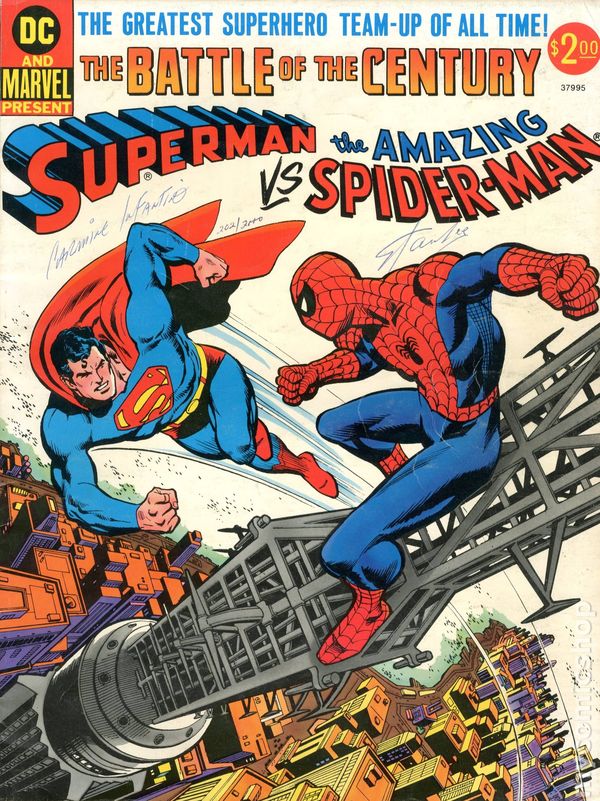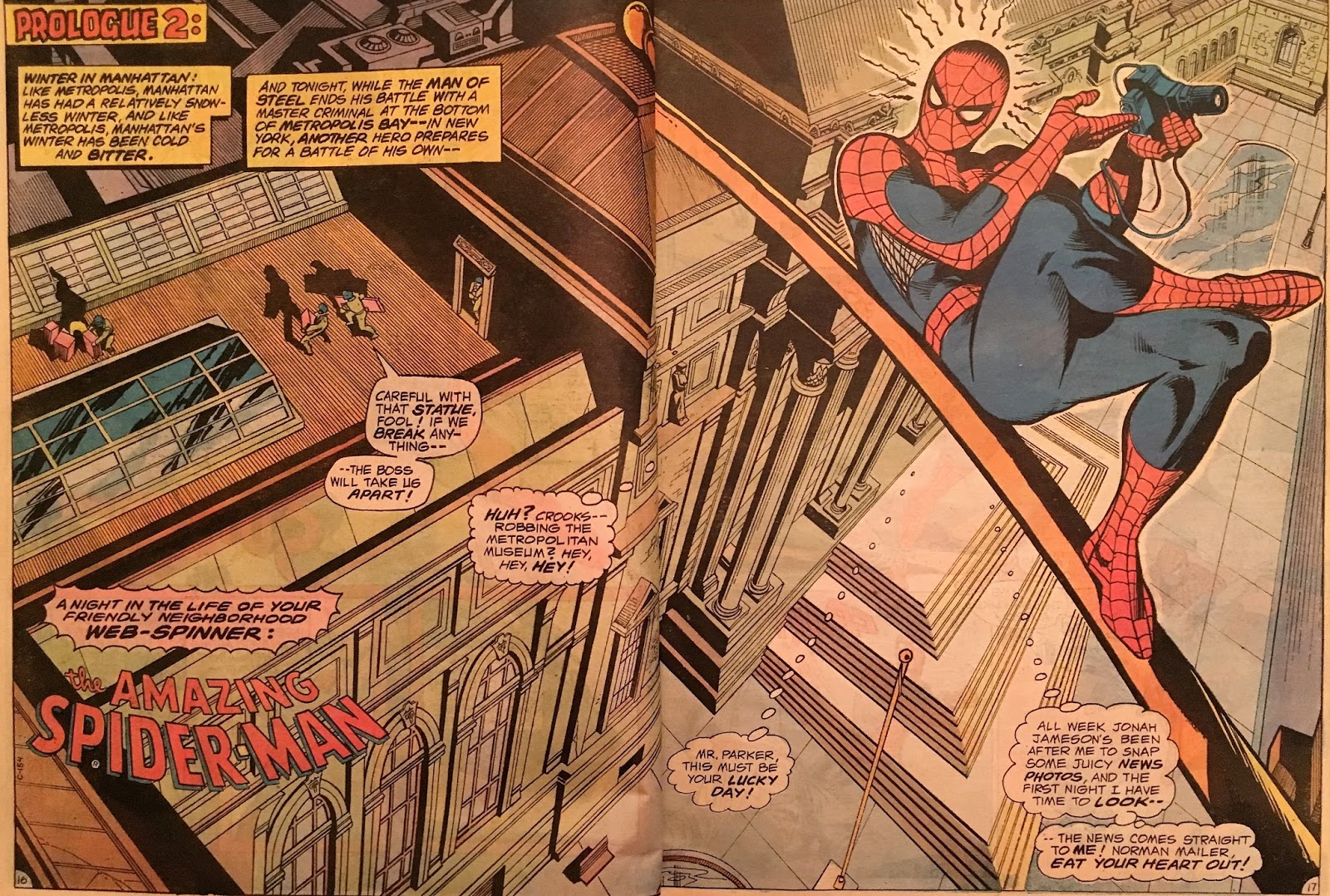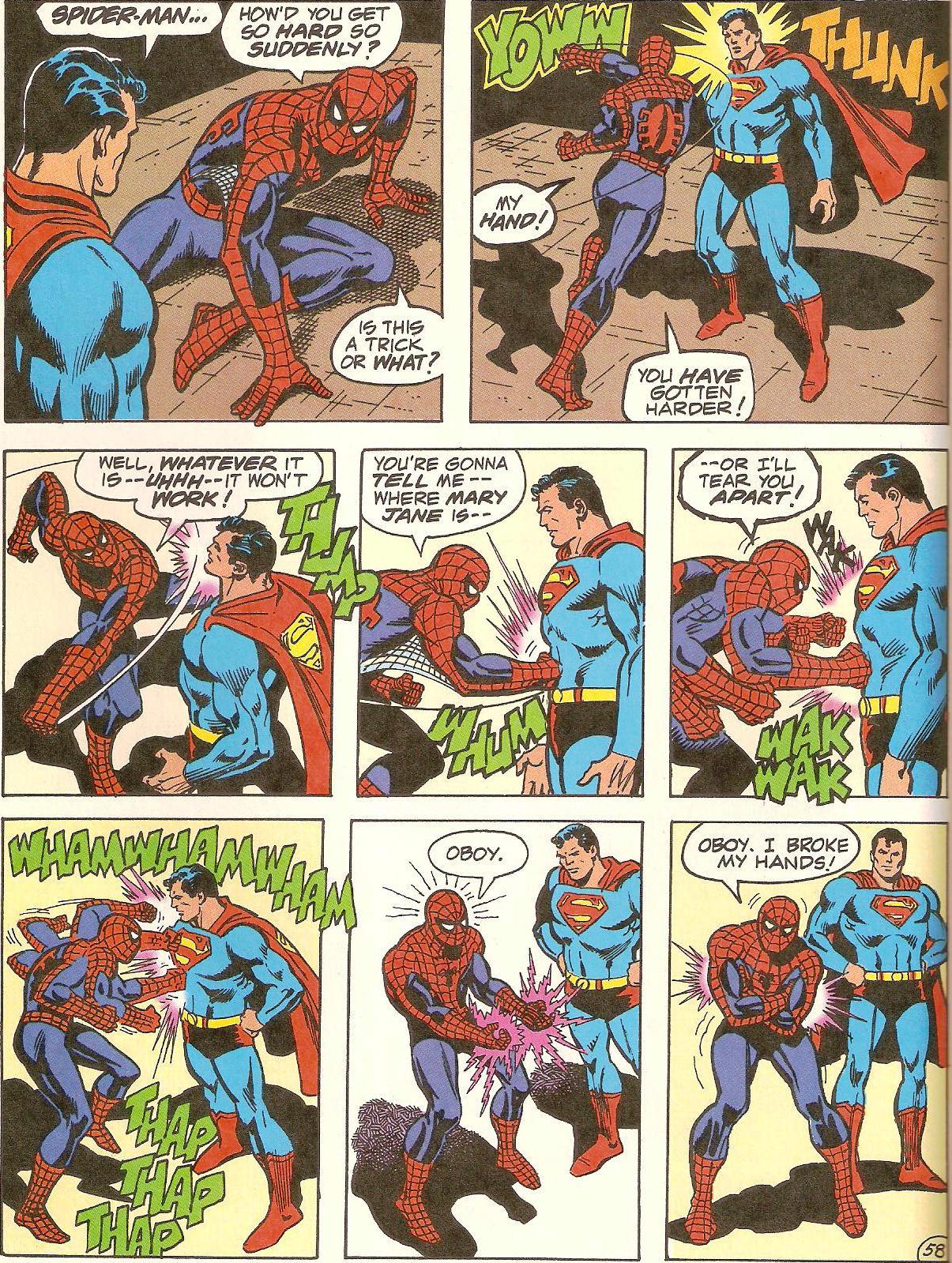Superman vs The Amazing Spider-Man

Story Title: “The Battle of the Century!”
Publication Date: 1976
CreditsScript: Gerry Conway
Pencils: Ross Andru; Neal Adams (uncredited, redrawing of major Superman figures); John Romita Sr. (uncredited, some Marvel faces)
Inks: Dick Giordano; Terry Austin (uncredited, backgrounds); Bob Wiacek (uncredited, backgrounds of three pages)
Colors: Jerry Serpe
Letters: Gaspar Saladino
Cover Art: Carmine Infantino (layout); Ross Andru (finishes & pencils); Dick Giordano (inks)
Synopsis: Superman rescues Metropolis from a giant-robot attack by his old foe Lex Luthor, who manages to send some sort of stolen device to one of his strongholds for safekeeping. Elsewhere (in New York), Spider-Man battles and defeats his longtime foe Doctor Octopus and his henchmen.
Sent to a federal "super-security" prison (designed for the incarceration of super-villains), Luthor and Doctor Octopus agree to combine forces in order to conquer the world and kill both of the men who put them behind bars. In a matter of minutes, combining their abilities, the two super-villains escape.
Newspaper photographer Peter Parker and Mary Jane Watson attend a press conference in New York City that features a new satellite, ComSat, capable of disrupting global weather patterns. Journalists Clark Kent and Lois Lane also attend, arriving by plane from Metropolis.
Peter saves Lois' life, and then introduces her to Mary Jane. In seconds, Lex Luthor, disguised as Superman, swoops in and shoots a teleportation ray out of his Superman mask, teleporting Lois and Mary Jane to an unknown destination. Luthor flies away, and both Peter and Clark soon follow him and change into their respective costumes.
Superman mistakenly blames Spider-Man for the disappearance of the two women. The two begin to fight, but dodge each other's punches. Superman flies away at super-speed, evading Spider-Man's next attack, while trying to deduce what is happening. Luthor fires a gun at Spider-Man, irradiating the hero's costume with light similar to that emitted by a red sun. The red-sun radiation negates Superman's invulnerability in regards to Spider-Man, unbeknownst to either hero.
This allows Spider-Man's punches to hurt Superman until the radiation dissipates, and Superman is again invulnerable. When his punches, instead of staggering Superman, suddenly have little effect, Spider-Man calls off the fight. Realizing they have been deceived, Superman, suspecting a plot by Luthor and Doc Ock, proposes they amicably join forces to solve the mystery and rescue the women.
Moving to Africa, Spider-Man and Superman battle Doctor Octopus, Lex Luthor, and a foe endowed by Luthor with super-strength and endurance and a red-sun irradiated sword. Spider-Man and Superman defeat the African warrior only by combining their powers. Spider-Man steals an Injustice Gang spaceship from Luthor's base in Africa and heads into outer space with Superman to confront Doctor Octopus and Luthor. The supervillains have used the Injustice Gang's Satellite Headquarters' computers in conjunction with the device stolen by Luthor to agitate the Earth's atmosphere with a combination of sonic waves and lasers, causing huge tornadoes and hurricanes worldwide. Superman is felled by the beam's high-pitched sonics and Spider-Man loses consciousness when the spaceship's oxygen is compromised.
The heroes awaken aboard the Injustice Gang Satellite, where Mary Jane and Lois are held captive. Superman defeats Doctor Octopus by tearing off two of his robotic arms and shattering his eyeglasses, while Spider-Man uses psychology to try to divide the villains. Doctor Octopus realizes that Luthor's scheme, if allowed to succeed, will effectively destroy human civilization, leaving them with "nothing to rule" even if they prevail against their heroic nemeses. He uses one of his robotic arms to destroy the weather machine's control console, stopping the potential disaster.
An enraged Luthor attacks and defeats Doctor Octopus. While Superman returns to Earth to stop a gigantic tidal wave from destroying most of the East Coast of the United States, Spider-Man defeats Luthor. Superman returns to the satellite, where Spider-Man has bound the two villains with his webs. Congratulating themselves on a job well done, Superman and Spider-Man take the villains into custody. In an epilogue, Clark and Lois go on a double date with Peter and Mary Jane.
A minor subplot of the story involves a barroom meeting between Daily Planet publisher and WGBS network chief Morgan Edge and Daily Bugle editor J. Jonah Jameson, in which the two irascible boss figures compare complaints about their employees Kent and Parker, and their respective propensities to suddenly disappear in the midst of crisis situations.
Character Appearances: Superman (Clark Kent; Kal-El); Spider-Man (Peter Parker); Lois Lane; Mary-Jane Watson; Lex Luthor; Doctor Octopus (Otto Octavius); Morgan Edge; Steve Lombard; Perry White; J. Jonah Jameson; Betty Brant; Robbie Robertson; Ned Leeds; Carmody
Comments: Beyond the historical significance of this being the first ever meeting between the two most prominent Marvel and DC heroes, this story interests me for two main reason. First, it could be said that this meeting signified a sort of “passing of the torch” between Superman and Spider-Man. By this point in 1976, Marvel had been outselling DC for about four years and this was the first time a superhero outside the DC universe was shown to be a more or less cultural equal (if perhaps only in the comic’s community) to Superman. Certainly Superman, having been around almost 40 years at this point, was still more well known to the mass populace, but the fact that a character that had only been around some 14 years had gained this much ground on the Man of Steel in the hearts and minds of comic fandom was telling in terms of Marvel Comics impact on the industry.
On a more personal note, the Bronze Age era is the one that I’m least familiar with when it comes to both characters, so it was interesting to see how they were being portrayed and perceived in the mid-to-late 70’s. Given the effort needed to get this comic into existence, and the convoluted backstory of its creation, it’s clear that a lot of care was taken to make sure that both character came off as an idealized version of what they’d evolved into at this point. That’s certainly my perception at least.
As far as the story itself goes, it’s understandably generic, but its hits most of the right beats and does what it needs to do to be entertaining. The opening two page spread of Superman encountering Lex’s giant robot is a thing to behold, as are most of the two-page spreads throughout the comic. There are three “page breaks” in the comic that give quick, pithy, one-page recaps of the heroes and villains origins. Superman and Spider-Man each get their own after their respective prologues, while Lex and Ock share one after they team up in the story. This is quaint by today’s standards, and I’m still not sold on it being a good idea to integrate these mini-origins into the story itself (later team-ups would limit the origins to the inside cover) but at least you got captions warning you that they were coming.
The strength of the story is clearly the visuals. As convoluted as it was to have Ross Andru’s art touched up by Neal Adams and John Romita, the art throughout is surprisingly consistent. My favorite visual, as I mentioned above, is the two-page opener where we see Superman flying, while using his X-Ray vision, to put a stop to Luthor’s rampaging robot. It doesn’t get more “comicbooky” than Superman fighting a giant, bordering on absurd, robot:

Spider-Man’s introduction into the story isn’t as visually interesting as Superman’s, but I found it appealing in an odd way. It’s just Spidey hanging out on a flagpole, camera in hand, while we get a huge shot of the museum and tiny crooks going about their nefarious ways. Thematically, I think this works well to show the slight difference between the Marvel and DC methodology. Superman starts out battling and over-the-top menace, while we first meet Spider-Man enduring what was up until then a boring night trying to make ends meet. He’s thinking about himself as “Mr. Parker” and we get to see him worrying about being able to sell some pictures to Jameson:

The best story sequence takes place after Luthor hits Spidey with a “red sun ray” that temporarily allows him to cancel out Superman’s invulnerability, and for a short time, Spidey is actually able to knock Superman around a bit. The best part is at the end, after the effect wears off, when we get to witness a bit of humor while Spidey gets subjected to a healthy dose of reality:

For the most part I enjoyed the story and felt it presented both Spider-Man and Superman in a positive light, didn’t feel overly forced and did a good job of entertaining me as a reader. The one part of the story that I flat out didn’t like was the unfortunate African sequence. After Spidey and Superman find out that Luthor has a lair located at Mt. Kilimanjaro, they fly there (Spider-Man is attached to Superman by his web and, for some reason, has fashioned himself a pair of web-ski’s…) only to meet a tribe of Masai warriors. Trying to gain Luthor and Ock’s exact location, Superman condescends the Masai and assumes that he needs to talk to them as if they were primitives. However, a warrior named Nu’chacka speaks up, in perfect English because he “studied in London,” and leads them to his chief who also happens to be his father. Unfortunately, his father will only reveal what he knows if Superman will perform a super-stunt for him. This is what Superman does:

Yeah. A bit of misplaced Silver Age goofiness, folks. This whole sequence just seemed out of place and could have been avoided altogether. It almost seems to me that Conway wanted to use the Wakandan’s but wasn’t able to, perhaps for legal reasons? Marvel and DC might have only agreed to the core supporting cast of Superman and Spider-Man respectively. I certainly don’t think it was meant to be in any way offensive, in fact it seemed to subvert an old cliché, but it is the one drop the ball moment for me in an otherwise fun and enjoyable adventure.
In terms of the creative team, it’s hard to judge Conway’s writing given the nature of this story. I’m sure he had Marvel and DC breathing down his neck, making sure everything was in place and nothing was too controversial or off model. Understandable. I think he did a serviceable job with the dialog, but some of it seemed almost intentionally old fashioned even for 1976. Having Superman and Spider-Man have a misunderstanding was very Marvel, while the team-up of Luthor and Doc Ock felt more DC to me. Maybe it’s because DC villains have always seemed to be better at working in groups? The art was great throughout, but seeing as how so many different artists and inkers worked on the book, it’s almost as hard to judge it on those terms. The layouts at least were all Ross Andru (at least in execution) and I think he did a fantastic job in that respect. It’s very apparent when Neal Adams and John Romita redid a face, but it all comes together surprisingly well. Giordano’s inks are solid as always, and even though Austin and Wiacek are uncredited as inkers, there are several Easter-eggs throughout that hint at their involvement (“Austin’s” as a store name, etc.).
Characterization: Superman comes off as you’d expect. He’s an authority figure, the embodiment of virtuous, intelligent and seemingly has an answer for every situation and trap. Spider-Man on the other hand makes mistakes; twice he forgets to refill his web-fluid, which almost costs him. While I think Superman and Spider-Man make a good team, they do have certain commonalities, there really isn’t much back and forth banter to speak of. Spidey attempts to crack jokes, but Superman simply doesn’t play along. He’s not annoyed, he’s not anything really, he just…doesn’t respond. I would have liked for DC to have allowed Superman to have been a bit less of a tight ass, to be honest, and I detect their direction in this part of his characterization. The rest of the cast seem all on model, though with the exception of Jameson and Edge, they each only get a few lines of dialog. Jameson comes off as a bit nuts, actually attacking Parker at one point because of the poor quality of his photo’s. He later pretends to be nice to Peter, only to take it all back and berate him for no apparent reason. Was Jameson going through a mid-life crisis in the late 70’s or was Conway simply trying to make sure that the casual reader understood what Jameson was all about?
Personal Rating: 7. Overall, this is an enjoyable read and something I’d recommend if you have an urge to read some unfiltered, straightforward, Bronze Age super-heroics. I think it works better as a Superman story as opposed to a Spider-Man story, given the globe-trotting and the final confrontation in space. Spidey piloting any kind of spacecraft has never really appealed to me. I get that it needed to happen because of the plot, but it just never looks right visually.
Historical Rating: 10. In terms of the crossover between big comic publishers, this was the first to feature their two biggest characters and is by far the most historically important. The classic cover alone has been homage many, many times over the years and for good reason.